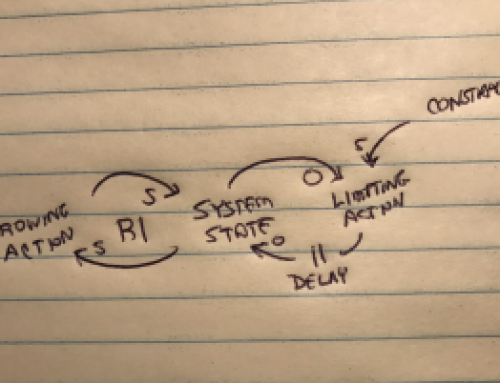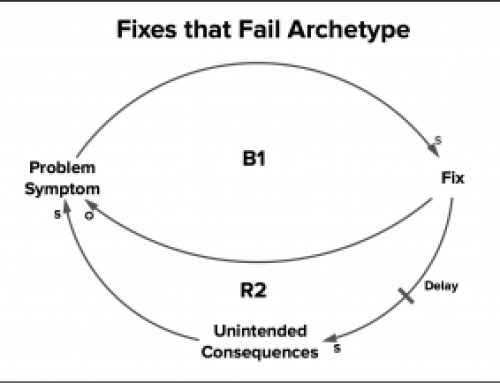 In your business, have you heard someone make statements that include phrases like, “If we had only known that …”, or “I wish I could have seen that coming.”, or “We didn’t make that connection.”? While there are certainly times that something totally “unpredictable” occurs in life or business, I assert that many of the situations that lead to the utterance of these phrases can be eliminated. What am I talking about? I am talking about the fact that so many decisions are made using information that only scratches the surface, or completely blind to unintended consequences, or with vision that is squarely on the tree in front of us rather than the larger forest where we find that tree. I am talking about approaching decisions in a way that moves well beyond the first level of information, intuition, and reactive responses to utilize a more disciplined and systematic method of thinking.
In your business, have you heard someone make statements that include phrases like, “If we had only known that …”, or “I wish I could have seen that coming.”, or “We didn’t make that connection.”? While there are certainly times that something totally “unpredictable” occurs in life or business, I assert that many of the situations that lead to the utterance of these phrases can be eliminated. What am I talking about? I am talking about the fact that so many decisions are made using information that only scratches the surface, or completely blind to unintended consequences, or with vision that is squarely on the tree in front of us rather than the larger forest where we find that tree. I am talking about approaching decisions in a way that moves well beyond the first level of information, intuition, and reactive responses to utilize a more disciplined and systematic method of thinking.
Why Systems Thinking?
So often business leaders are left wondering why certain problems exist or resurface, or why their best plans fail or result in completely unintended results and consequences. At the same time, so often these results could be predicted well in advance and completely avoided through the disciplined use of systems thinking. Don’t worry; this is not going to lead you down a path that simply adds a whole new level of complexity to solving problems. In fact, the whole idea is to simplify and clarify specific decisions through recognizing predictable patterns or at the very least, expected patterns that you can plan for and use.
Last year, as I was preparing for an upcoming trip, I saw a Groupon for a new sedan/limo service offering a special roundtrip rate to and from the Chicago airport. I booked this deal online and then called to book my roundtrip. What happened after this was quite an ordeal. Basically, this new service completely lacked the forethought to manage the number of calls and service commitments that the Groupon sale generated. They were disorganized, lacked the resources to fulfill on their commitments, handled my entire trip poorly, and ultimate Yelp! And other social media outlets were full of negative reviews and comments regarding this new business. Needless to say, they are going to face an uphill battle in this market with such a negative start.
What about a new senior executive hired to oversee operations who immediately sees so many “quick” changes that can be made to centralize specific support services? This executive outlines decisions that look great on paper with the CFO. This executive is going to look like a hero in delivering more to the bottom line. However, this executive overlooks key dependencies relating to customer service, feedback, quality assurance, etc. Over time, these decisions cause great customer dissatisfaction through slower service, lower quality of service, less communication between customers and sales, and ultimately loss of customers and profit.
In the late 1980s, a leading computer manufacturer was selling a very profitable line of business computers (mini computers). This manufacturer then launched a brand new line of computers based on a completely different operating system platform and truly designed more for a few niche markets. However, the product brand team launching this new product was so zealous to get traction, they offered the manufacturer’s sellers extra bonus commission and points (points toward their “annual golden circle” type of club – with a nice vacation at stake) when selling this new business computer. The results? Well, the manufacturer sold quite a few of the new computers, more sales people than ever made the “club” and more earned higher wages. However, the manufacturer’s profit margins went down and the first business unit that had been selling higher margin units started experiencing very slow sales. One hand … did not talk to the other … and some very excited brand manager dictated a course for the company that was certainly unintended!
All of these examples likely generated statements like “if we had only thought of that … or known that … or talked about that.” We could go on and on with examples like unexpected fall in sales revenues due to a successful rebate/discount program in the prior quarter (predictable), a complete miss on a new product launch due to underfunding and lack of “all in” commitment (predictable), or the all too common slow drain and failure of a business due to profit margin management (again, predictable). All of these examples are about decisions made while leaders failed to systematically think in terms of identifying possible unintended consequences, recognizing limiting resources, delays that may exist between cause (decision) and effect (consequences), or in terms of creating vicious cycles of amplifying forces – all predictable patterns within the discipline of systems thinking. Why systems thinking? Because systems thinking offers you skills and a framework for recognizing and evaluating all of the forces that truly exist within the system you manage and offers you predictable patterns (archetypes) that have been identified throughout countless years of research and study that can assist you greatly in making smarter decisions.
What IS Systems Thinking?
As Peter Senge, author of The Fifth Discipline (…) says, “… it should come as no surprise that the unhealthiness of our world today is in direct proportion to our inability to see it as a whole. . . . Systems thinking is a framework for seeing wholes.” When business leaders, or for that matter anyone facing decisions, sees only a particular snapshot view of what is going on around them, systems thinking offers the ability to see and recognize patterns of change and a set of general principles that has been well researched and written about over a long period of time and spanned the fields of physical and social sciences, engineering, and management. The discipline of systems thinking is rooted in the “feedback” concepts of cybernetics and also in the “servo-mechanism” theories of engineering that both date back over one hundred years. While it may sound super geeky, the elegant and quite simple core value of systems thinking is how sensible it really is to examine the subtle interconnectedness of entities within the living structure we call business. It is a dynamically complex structure of many living business systems, feedback forces, delays, and independent and yet dependent decisions that we must navigate.
With that said, what are the fundamental elements of systems thinking that are important to embrace and examine more closely?
- Systems thinking is about seeing the whole and the process vs. just snapshots, parts, or specific details.
- Systems thinking shifts your view of yourself and others from being helpless “reactors” to being “active participants” that shape the present reality and future.
- The value (leverage) of systems thinking lies in examining the dynamic complexities, not detailed complexities, of any given situation (interconnectedness of feedback forces and delays vs. just the timeline of events as they appear).
Where Do You Start in Systems Thinking?
We all recognize this kind of natural and intuitive thinking in some of the good leaders we know. However, great leaders cultivate this discipline, mentor this discipline, and ensure that all of their business leaders follow the discipline of systems thinking. So, where do you start? Now that I have given you the “why” and an overview of the “what” regarding systems thinking, the fun can begin in terms of exploring some of the basic fundamentals of systems thinking along with the primary archetypes (regular patterns/models) that exist to assist you. In my next blog post on this topic I will examine the most basic building blocks “feedbacks” and “delays.” And don’t worry, I will talk about business and business decisions and how these feedbacks and delays actually exist in the business world.
Confessions of a Systems Thinking Newbie
Building Blocks of Systems Thinking: Obvious and Hidden Forces
Raise Your Competitive Thinking IQ: Challenge Intuition
Raise Your Competitive Thinking IQ: Recognizing & Managing Mental Models
Raise Your Competitive Thinking IQ: Giving Voice to the “Unspoken”
Raise Your Competitive Thinking IQ: Make Room for All Voices

